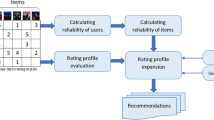Abstract
Recommendation with better accuracy is one of the major concerns. The most of the existing works focused on the user–movie ratings and the movie features for offering the solution. But in context of today’s OTT platform, the consumers’ (users) attributes are supposed to be available and need to be considered as one of the decision variables within the recommendation process. We have attempted to propose a better recommendation scheme that considers all these three inputs (user attributes, movie features, user–movie rating) as decision variables. The contribution is to prepare a user (movie) profile that represents an affinity pattern of the specific user in context of movie rating. The said profiling approach helps to create groups of the homogeneous users (in terms of movie rating) that in turn assists in the process of more accurate recommendation. The proposed concept is implemented through rigorous experimentation on benchmark data sets for necessary validation. Moreover, we have compared the proposed approach with the notable existing approaches and significant improvement is noted.



Similar content being viewed by others
Data availability
The data sets analyzed during the current study are available in the “GroupLens - MovieLens 1 Million Dataset” repository, https://grouplens.org/datasets/movielens/1m and in the “The Movies Dataset” repository, https://www.kaggle.com/rounakbanik/the-movies-dataset
References
Bennett J, Lanning S (2007) The netflix prize. In: Proceedings of KDD cup and workshop, vol 35
Liu H, Zheng H, Mian A, Tian H, Zhu X (2014) A new user similarity model to improve the accuracy of collaborative filtering. Knowl-Based Syst 56:156–166
Deng J, Wang Y, Guo J, Deng Y, Gao J, Park Y (2019) A similarity measure based on Kullback–Leibler divergence for collaborative filtering in sparse data. J Inf Sci 45(5):656–675
Yong Wang, Wang Pengyu, Liu Zhuo, Zhang Leo Yu (2021) A new item similarity based on \(\alpha -divergence\) for collaborative filtering in sparse data. Expert Syst Appl 166:114074
Singh PK, Sinha M, Das S (2020) Enhancing recommendation accuracy of item-based collaborative filtering using Bhattacharyya coefficient and most similar item. Appl Intell 50(12):4708–4731
Son J, Kim SB (2017) Content-based filtering for recommendation systems using multiattribute networks. Expert Syst Appl 89:404–412
Ai J, Liu Y, Zhan S, Zhang H, Zhao F (2019) Link prediction in recommender systems based on multi-factor network modeling and community detection. EPL (Europhysics Letters) 126(3):38003
Su Z, Lin Z, Ai J, Li H (2021) Rating prediction in recommender systems based on user behavior probability and complex network modeling. IEEE Access 9:30739–30749
Walek B, Fojtik V (2020) A hybrid recommender system for recommending relevant movies using an expert system. Expert Syst Appl 13:113452
Su Z, Zheng X, Ai J, Shen Y, Zhang X (2020) Link prediction in recommender systems based on vector similarity. Phys A 560:125154
Zhang J, Wang Y, Yuan Z, Jin Q (2019) Personalized real-time movie recommendation system: practical prototype and evaluation. Tsinghua Sci Technol 25(2):180–191
Widiyaningtyas T, Hidayah I, Adji TB (2021) User profile correlation-based similarity (UPCSim) algorithm in movie recommendation system. J Big Data 8(1):1–21
Kullback S, Leibler RA (1951) On information and sufficiency. Ann Math Stat 22(1):79–86
Adomavicius G, Tuzhilin A (2005) Toward the next generation of recommender systems: a survey of the state-of-the-art and possible extensions. IEEE Trans Knowl Data Eng 17(6):734–749
Fischer CS (1982) To Dwell among friends: personal networks in Town and City. University of Chicago Press, Chicago
Ester M, Kriegel H-P, Sander J, Xiaowei X (1996) A density-based algorithm for discovering clusters in large spatial databases with noise. In: kdd. vol 96(34), pp 226–231
Jaccard P (1901) ’Etude de la distribution florale dans une portion des alpes et du jura. Bull Soc Vaud Sci Nat 37(142):547–579
Adamic LA, Adar E (2003) Friends and neighbors on the web. Social Netw 25(3):211–230
Ravasz E, Somera AL, Mongru DA, Oltvai ZN, Barabsi AL (2002) Hierarchical organization of modularity in metabolic networks. Science 297(5586):1551
Han J, Pei J, Kamber M (2011) Data mining: concepts and techniques. Elsevier, Amsterdam
Breiman L (2001) Random forests. Mach Learn 45(1):5–32
Drucker H, Burges CJ, Kaufman L, Smola A, and Vapnik V. (1996) Support vector regression machines. Adv Neural Inf Process syst 9:155–161
GroupLens - MovieLens 1 Million Dataset: https://grouplens.org/datasets/movielens/1m
Banik R, Kaggle—The Movies Dataset: https://www.kaggle.com/rounakbanik/the-movies-dataset
Seyednezhad SM, Cozart KN, Bowllan JA, Smith AO (2018) A review on recommendation systems: Context-aware to social-based. arXiv preprint arXiv:1811.11866
Polatidis N, Georgiadis CK (2016) A multi-level collaborative filtering method that improves recommendations. Expert Syst Appl 48:100–110
Author information
Authors and Affiliations
Corresponding author
Ethics declarations
Conflict of interest
The authors have no conflict of interest.
Additional information
Publisher's Note
Springer Nature remains neutral with regard to jurisdictional claims in published maps and institutional affiliations.
Rights and permissions
Springer Nature or its licensor holds exclusive rights to this article under a publishing agreement with the author(s) or other rightsholder(s); author self-archiving of the accepted manuscript version of this article is solely governed by the terms of such publishing agreement and applicable law.
About this article
Cite this article
Goswami, S., Roy, S., Banerjee, S. et al. A profiling-based movie recommendation approach using link prediction. Innovations Syst Softw Eng (2022). https://doi.org/10.1007/s11334-022-00472-4
Received:
Accepted:
Published:
DOI: https://doi.org/10.1007/s11334-022-00472-4




